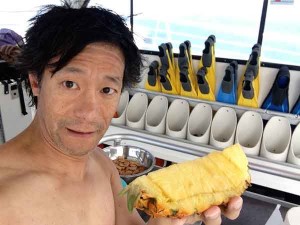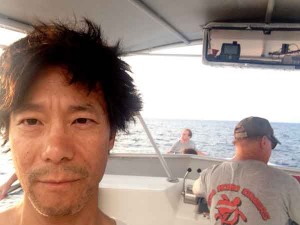Kona Hawaii Scuba Diving With Manta Rays
I went to Kona, big island Hawaii in early September to do the famous manta ray dives. My diver buddy Thomas and I stayed at a little boutique hotel (17 rooms only) right by the ocean called Kona Tiki Hotel just five minutes south of the main tourist retail area. This hotel was well recommended although their website is pretty sparse and you do have to put a deposit in advance. I wrote up about our time topside in a separate three part post at my Big Island Hawaii Travel Report and just focus on the scuba diving for this one.
The dive operator we used was Kona Honu Divers and their shop is in town. Their only boat is docked at a small boats marina about five minutes north on the main number 19 highway between town and the airport. Once you check in the first time at the shop, you just meet at their boat for all of the dives.
We started with two morning dives on local Kona reefs followed with a manta ray dive in the evening. The next day, we did another two morning reef dives and then returned for a twilight (late afternoon) dive at the same site of the manta ray dive followed by our second manta dive when it was dark enough as a night dive.
First of all, the boat is a pretty standard dive one well equipped with a head (toilet), covered inside deck, upper deck where the captain is and access to the front deck. The crew had lots of snacks and even freshly cut pineapple during the morning dives.

Weird thing I observed was although they have only one boat, each of the four dive trips we went out on featured a completely different captain and almost a complete changeover of divemasters. I don’t know if there was some job sharing thing going on or not with the crew but September was after their busy high summer season. The main tourist drag in Kona was actually never that busy at all both daytime and evenings when we were there.
Some interesting differences I found with Kona Honu Divers – first, they set everyone up with proper weights and instead of using weight belts, they all use bean bag type of weights which they put in BC pockets or integrated weight systems for those who have them.
One thing I really liked about Kona Honu Divers was their valet style of entering the ocean. Instead of everyone putting on their BCs and fins, then walking to the back of the boat, they have two metal seats at the back. They then had each diver without fins or BC on, sit on one of these seats. Then a crew member will carry the BC/tank over and help put on the gear. Each diver also puts on their fins at the back of the boat too. Then it’s simply standing up and doing a giant stride into the ocean.
This did result in waiting a bit for everyone else to get into the water especially when I was often the first diver in but perhaps it’s a bit of a safer way without anyone wiping out on the boat deck with fins and full gear on. The return to the boat was otherwise the same as with other standard dive boats.
General Kona Hawaii Scuba Diving
For the reef dives, I must say that overall, I was not that impressed with the dive sites at Kona. I think the divemasters did their best in finding interesting marine life but from my observation, the coral reefs here are not as colourful and the marine life is not as abundant compared to many of the better Caribbean dive sites or even at Key Largo, Florida. However. there were some smaller fish that we saw that were indigenous to Hawaiian waters though.
Some of the divemasters from Kona Honu Divers were quite good while I found the odd one a bit too fast for the group, especially since most of the waters there had a mild current. Near the end of the dives, they would send the divers low on air towards the boat to hang out at until it was time to do safety stops. The rest of the group would go a little longer.
Sometimes this worked while sometimes I can see that divers low on air still could not see where the dive boat was so they had to find it on their own, even as single divers (the divemasters did not enforce buddy diving).
The Kona Manta Ray Dives
Now for the Kona manta ray dives. These were night dives and most dive boats I saw on site had both scuba divers and snorkellers. Some boats were strictly snorkellers only. The snorkellers stayed on the surface holding a special lighting rig throughout the manta encounter. These rigs shined light towards the bottom.
The divers were all given a dive light attached to their BCs. We followed the divemasters to an area called the Ball Park which is a relatively open area on the bottom about 45 feet down. Here, we either kneeled down or sat on the bottom. Although most divers were on their knees, I personally found it easier to stay in one place by sitting since there was a mild surge at the bottom rocking some divers back and forth.
Even with a few pounds of extra weight which we were all recommended to pack for this dive, there were divers being knocked over by the surge at times. While at the bottom, we were to hold our lights up towards the surface.
The lights attract plankton which in turn attract the manta rays. During the first night, there were 8 manta rays while the second night, they counted 17.
Here’s a video (not of us though) that shows the same manta ray dive in Kona.
What really surprised me was just how close these mantas come to the divers. They would typically come towards our heads because that’s where the lights are. Then they would literally be a few inches away from the tops of our heads. Each manta then typically would do this jet fighter plane barrel roll and go upside down before coming at us for a second or third time. The video above shows these barrel rolls by the manta rays quite nicely.
This type of behaviour went on for 45 minutes so whether there were 8 mantas or 17, the actual show really looked the same. We were briefed before hand on a few regular known manta rays including Big Bertha who is the largest female with a wingspan of 17 feet and estimated weight of 1,700 pounds. There was also Tim who has a paralysed left fang. We saw both of them during both nights.
Here is another video which shows how close the manta rays come to the scuba divers. You can also see that some mantas have a pink area underneath. This is actually an infection due to removal of a protective mucus layer they have because either they lost some of it while rubbing on coral or a diver touched it. This is why during our briefing, we were told not to touch any of the manta rays no matter how close they got to us. Although it was very tempting to actually touch one of them, none of the divers in our group at least, broke this rule and kept our hands to ourselves.
The divemasters came around and checked our air levels about halfway through the dive and at the 45 minute mark, requested everyone to head back to the boat. I found it quite amazing how they found our boat because there were about 12 boats on site and none had any lights below their boats like I saw at other destinations. They said that during the busy summer season, there could be as many as 25 boats.
Overall, I found Kona Hawaii to be just a barely average destination for the reef dives. Hawaii was a long way to go for dive sites I could easily find in the Caribbean and even in the Florida Keys. I found many dive destinations to have more colourful reefs and more plentiful marine life compared to what I saw in Kona waters. But the manta ray dives were definitely world class and a top big animals encounter that nobody will ever forget.
For divers into big animals, you might see manta rays elsewhere but at Kona, they will come within inches of your face during these night dives. Even during the twilight dive, we did see a few manta rays but they never came close to us. I think it is only during the night dive with our lights shining that we could see them up close. So far, I think this is the only place in the world where they will come that close to you and for 45 minutes non-stop.
So the scuba diving top big animals encounters lists that we see published that list Kona Hawaii as a top pick are correct. This is the way I originally heard about Kona as a potential scuba diving destination in the first place.
Despite the quality of the reefs, Kona Honu Divers did a good job overall with their dives, including the manta ray dives. They also have a special night dive called black water which is out in the open ocean at night and the attractions are the unique marine creatures from the deep that come up at night. They have this dive only once per week and it would have been interesting to do this one.
Big island Hawaii has other interesting land attractions including breathtaking coastlines, volcanoes and lava flows as well as two mountains to climb. We circumvented the entire island for the next three days of our stay and I report on our experiences in a series of blog posts starting with a Kona Big Island Hawaii Travel Report. In our opinion, the manta rays were the highlight of our trip. Everything else was good but nowhere near the level of the mantas.
Personally, I am not in a hurry to return to big island Hawaii anytime soon because of the quality of the coral reefs but I may someday just return to do the Kona manta rays again as well as the black water dive and then head out to try some of the other islands.

